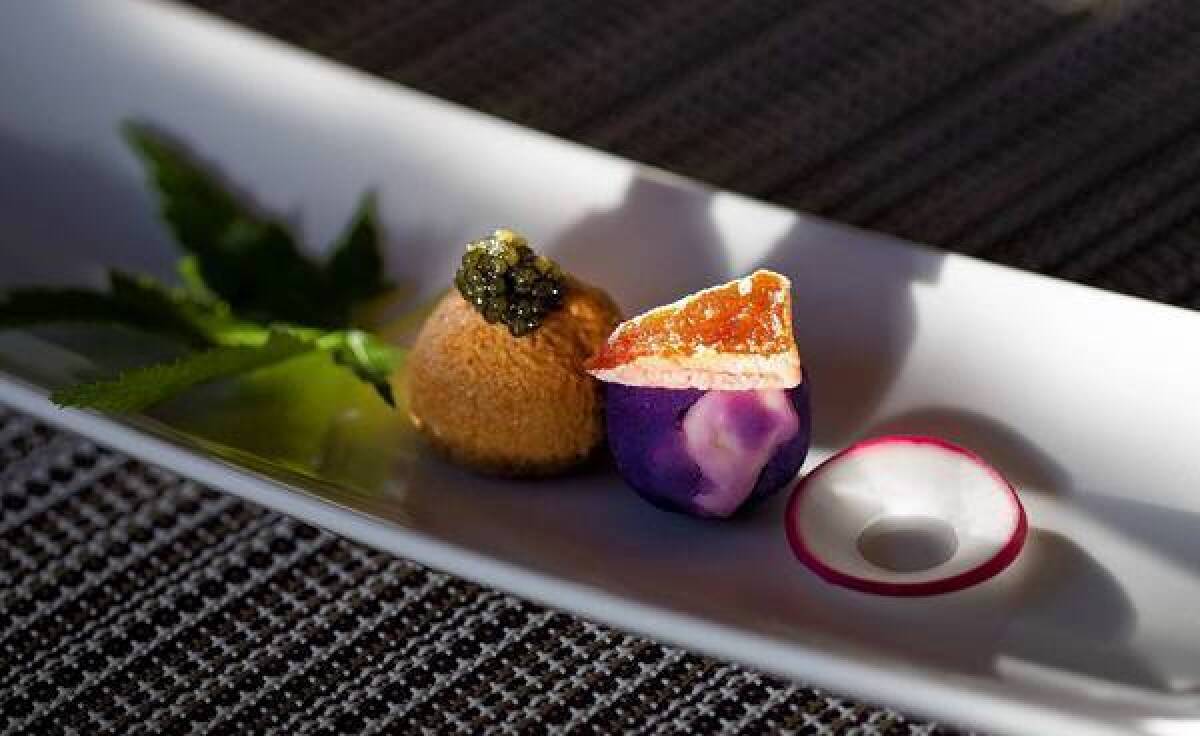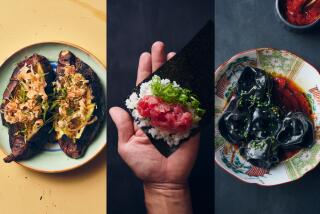Counter Intelligence: Shunji is no ordinary sushi bar

- Share via
We all think we know what to expect from a great sushi meal in Los Angeles, a progression of fish and rice that runs from the vinegared dish at the beginning to the warm crab hand roll at the end. If we are in a restaurant influenced by Nobu Matsuhisa, there may be some ceviche or spicy tuna along the way; if we are at a modern sushi bar, there may be cooked oysters or a salad.
So the last thing I was expecting on my first visit to Shunji Japanese Cuisine, the Westside restaurant that is the newest darling of local raw-fish cognoscenti, was a bowl of vegetables, served at the sushi bar, at the point in the meal where you might be expecting an elaborate sea urchin presentation or a saucer of tuna nuta.
Shunji is not an ordinary sushi bar.
It’s not just Shunji’s modest location. The Canoga Park sushi bar Go’s Mart serves its high-quality fish in a run-down strip mall. The fantastically expensive yakiniku restaurant Totoraku operates out of a ‘70s-era teriyaki hut. The late Ginza Sushiko, once the most expensive restaurant in the United States, spent years in the corner of a fast-food dominated Koreatown mini-mall.
Some of the best Japanese restaurants in Los Angeles have always occupied some of its grungiest real estate. It is the expensive, hyper-designed places that are more likely to close within a year or two — a chef can spend his money on brokers’ fees, or he can invest in high-quality fish.
Still, even by Los Angeles standards, the home of Shunji Japanese Cuisine is pretty odd for a sashimi-intensive restaurant: From the outside, the former home of Mr. Cecil’s California Ribs looks like a giant chili bowl in the shadow of the 10 Freeway. The bathrooms are outside. To exit the parking lot, you drive through a working welding yard. And, in fact, Chili Bowl was once the name of the place, built at the height of the Great Depression. It is hard to imagine what the first customers might have thought if somebody had told them that the diner would one day be a restaurant where people would submit themselves to abalone livers and chopped sardines.
Shunji is the playground of Shunji Nakao, a slender, gray-haired chef with the bearing of a patriarch in an old Ozu movie, a master who has commanded a following among local sushi fanatics for decades. He was one of the three original chefs at Matsuhisa, the Beverly Hills counter that spawned an international raw-fish empire. He founded the sashimi-intensive Asanebo, long famous among aficionados as the no-sushi sushi bar, which is still one of the best Japanese restaurants in town. He served short but significant terms at the Hump and at Tengu in Santa Monica. He was chef at a West Hollywood sushi bar also called Shunji before he left to open here in the chili bowl. The chili bowl feels like home.
At Shunji, you will find freshly grated Japanese wasabi; thickly cut slabs of ginger still attached to their green roots; and hard-to-get fresh yuzu. You will be dimly aware of the crew of prep guys who allow Nakao to shine as a soloist. You may be invited to taste Ichigo, a fragrant sake Nakao helped brew in Japan.
The basic unit of consumption at Shunji, as it is at most high-end sushi bars, is the set-course meal, the tasting dinner at $80. The omakase, or more elaborate tasting dinner, is $120 and up. There is an actual paper menu, and a list of dishes chalked carefully onto a blackboard, but what you eat depends on what has made it here from the market each morning and the whims of Shunji himself.
Perhaps there will be a bowl of crunchy, vinegared jellyfish to begin with, presented with a cylinder or two of simmered root vegetables for contrast, or maybe a dish of hair seaweed, manipulated into maximum sliminess, supporting a slightly seared fillet sprinkled with a bit of sea salt. You may see a fat, sliced sea scallop in a miso emulsion; a tangle of slivered sardines with a few drops of a soy-ginger reduction; and a bowl of creamy sesame tofu with a crumpled sheet of housemade tofu skin. On some occasions, Shunji presents a martini glass filled with noodles he has made from ground snapper, garnished with a lobe of sea urchin roe and a shower of summer truffles.
One long platter may display rounds of sliced octopus tentacle, lightly glazed with a blowtorch, and flanked with thin slices of spicy cucumber pickle and crunchy white asparagus tips. Another may hold a whole simmered abalone and a few Western-influenced dishes: purple mashed potatoes molded into a marble around a bit of blue cheese; a chunk of rough, handmade tofu wrapped in prosciutto; shrimp stuffed with sweet potato like a traditional Japanese sweet; and a tiny sphere of ankimo, monkfish liver tricked out to resemble the airiest possible Jewish chopped liver, and topped with a gram or so of caviar.
You will probably be served an impossibly luxurious concoction of julienned raw squid, squid ink, sea urchin and black truffles, a dish as dense as mercury with a quail egg floating on the surface, a vivid yellow eye set in a sea of pure blackness. You will be instructed to break the yolk halfway through the dish, and when you do the tarry mass takes on a lightness, a pleasant ooziness that transforms it almost into another dish.
This is a chef whose most famous dish is something he calls tomato tofu, a cube of tomatoes compressed into the size of a toddler’s building block, lightly cooked, and bathed in fragrant dashi. Nakao’s sushi is excellent — the lightly pickled salmon is especially nice, and he is not immune to the charms of a well-made Dungeness crab roll — but you can get through a meal here without seeing sushi at all.
There is a simple sashimi course, slips of porgy, grouper and other mild summer whitefish, set side by side on a long platter, accompanied by dustings of Japanese and Australian sea salt, and, perhaps, a tiny dish of syrupy ponzu sauce. Nakao replenishes the sashimi on your plate, almost without you being aware of it, with slivers of other fish. By the time you finish the course, you are less aware of aka hata, ara or chikami kintoku than you are of the shifting, clean taste of Japanese summer.
If you come on a day when the fish have arrived from Japan, Nakao may pluck your sashimi from a sleek, metal attache case that looks like it might contain nuclear codes instead of seafood. If not, he may pluck the fish from neat overhead refrigerators, from under the counter, or from the hands of his assistant.
No glass case separates you from the chef, whose presence verges on the uncomfortably close. You are close enough to see him wield his blowtorch less as a magic caramelizing tool than as something akin to a suede brush, coaxing albacore or sea bream into their maximum loveliness. Often you are not aware the torch has been used until you encounter a wisp of crisp skin or a touch of char added almost as a seasoning.
And those vegetables! The arrangement has the solid inevitability of a Noguchi sculpture — the green beans, okra, zucchini and peeled Japanese squash set against one another according to some immutable law. Each vegetable is cooked or not cooked to the point where it expresses its optimal sweetness, squeaky raw or poached to lusciousness, then put together in a shallow puddle of barely gelled dashi. You expect expensive wild sea bream to be treated reverently at a sushi bar. You do not expect the same care to be taken with a carrot.
Shunji details
Location: 12244 W. Pico Blvd. (near Centinela Avenue), Los Angeles, (310) 826-4737, shunji-ns.com
Prices: Tasting menu $80; omakase $120 and up
Details: Dinner Mon.-Thu., 6 p.m. to 10 p.m.; Fri.-Sat., 6 p.m. to 10:30 p.m. Major credit cards. Beer, wine and sake. Lot parking.
ALSO:
More Jonathan Gold’s Counter Intelligence
More to Read
Inside the business of entertainment
The Wide Shot brings you news, analysis and insights on everything from streaming wars to production — and what it all means for the future.
You may occasionally receive promotional content from the Los Angeles Times.











